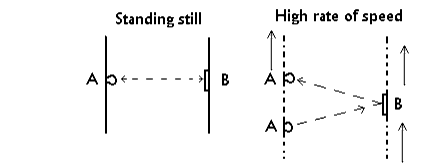Chapter 0-Page 0
2. No matter how a light source moves compared to us, the light will always pass us at the same speed. Huh, the same speed? We'll look at this puzzle some more, later.
What was so special about the theory? In one way, it's special because it explained why the 1887 experiment didn't find an ether wind. Newton believed there was no mechanical method that would decide between moving and standing still. The Special Theory of Relativity said light cannot be used either, but in another sense, it's called "special." Ten years later, Einstein proposed the "General" Theory of Relativity which included the theory we just described as a special case. The general theory took gravity into account.
That does it! We can't even use light to find absolute uniform motion anywhere, anyhow. Light speed always measures the same.
HOW DOES THE STEADY SPEED OF LIGHT AFFECT TIME
What's the connection between the speed of light and time anyway? One thought experiment shows why we can't depend on time running the same anymore. In the picture below, the elevator on the left stands still, relative to us. The one on the right flies up at an amazing speed. In both elevators, a beam of light travels from A to B with a mirror at B.

If we measure the beam of light in the left elevator from A to B and back to A, we will find it to have the correct light speed by our clock.
Chapter 0-Page 0